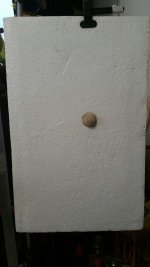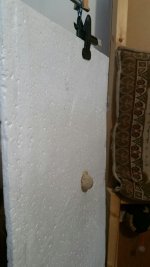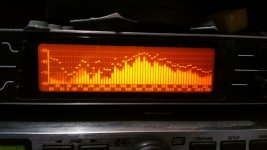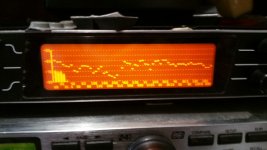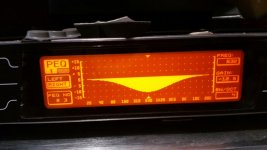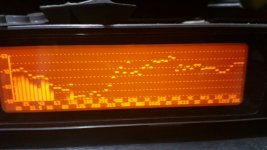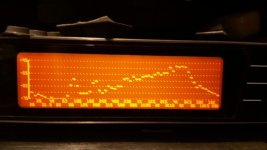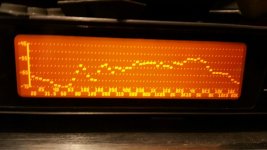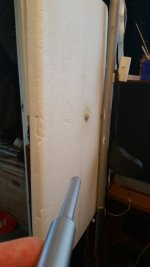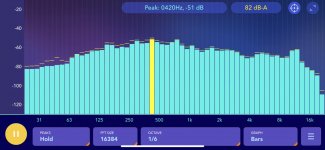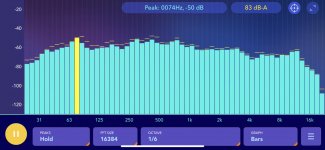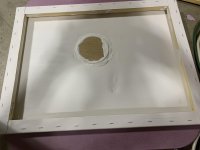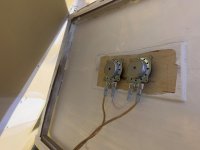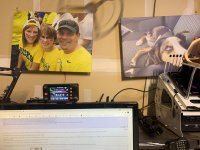Another...
Typical Ben
How I made my Bamboo DML Speakers
Description:
Typical Ben
9 subscribers
(Skip to 13:30 if you just want to hear them in action)
Sorry it's a bit longer than I intended, but for those asking about my panels, this is how I made them.
These are my first attempted to make DML speakers that sound AND look good. I should probably experiment on cheaper materials first but once I have the idea I tend to be a bit impulsive...
My panels are made from 2.5mm thick carbonised bamboo plywood, and I've coated them with danish oil to bring out the natural grain a bit. They're hanging on customized bamboo clothes racks I found on Ebay - I didn't want to hang them on a wall as they really need room to breathe (like most speakers they sound better when you move them away from the wall) for best results.
The panels are powered by a single 40w Dayton Audio exciter per channel, with no fancy electronics needed. They run full range, although due to the limitations of panel size and other factors, really need to be accompanied by a subwoofer - in my case a Canton 10.3 powered unit that rounds out the sound nicely.
I've started to experiment with bracing the panels for less flex (stiffness is desirable) and my next steps will probably be to progress this aspect of the build further.
Overall, while they're not perfect, I'm pretty happy with my first DIY audio project and in fact I already have my next DML speaker project underway!
Typical Ben
How I made my Bamboo DML Speakers
Description:
Typical Ben
9 subscribers
(Skip to 13:30 if you just want to hear them in action)
Sorry it's a bit longer than I intended, but for those asking about my panels, this is how I made them.
These are my first attempted to make DML speakers that sound AND look good. I should probably experiment on cheaper materials first but once I have the idea I tend to be a bit impulsive...
My panels are made from 2.5mm thick carbonised bamboo plywood, and I've coated them with danish oil to bring out the natural grain a bit. They're hanging on customized bamboo clothes racks I found on Ebay - I didn't want to hang them on a wall as they really need room to breathe (like most speakers they sound better when you move them away from the wall) for best results.
The panels are powered by a single 40w Dayton Audio exciter per channel, with no fancy electronics needed. They run full range, although due to the limitations of panel size and other factors, really need to be accompanied by a subwoofer - in my case a Canton 10.3 powered unit that rounds out the sound nicely.
I've started to experiment with bracing the panels for less flex (stiffness is desirable) and my next steps will probably be to progress this aspect of the build further.
Overall, while they're not perfect, I'm pretty happy with my first DIY audio project and in fact I already have my next DML speaker project underway!
Another YT Channel...
I AM SASA
DIY DML Speakers
I AM SASA
281 subscribers
#DIY Speakers
#Vibration Speakers
#DML Speakers
#Resonance Speakers
#Exciter Speakers
Two plywood board 2'x4' 3mm thick trimmed corners. Each with 2 4Ohm 15Watt exciter connected in series. One placed at dead center the other using the 2 5th 3 5th ratio.
Driven by an amplifier BRZHIFI Bluetooth 2.1 50wattx2 +100watt subwoofer not connected. Power supply 24volt 10amp brick bringing my total amplifier power to more than 200watt.
Music: from YouTube no copyright background music.
Please comment and subscribe if your enjoy this video. Any inquiries regarding my project please email me syedbsa@yahoo.com.
Thank You.
I AM SASA
DIY DML Speakers
I AM SASA
281 subscribers
#DIY Speakers
#Vibration Speakers
#DML Speakers
#Resonance Speakers
#Exciter Speakers
Two plywood board 2'x4' 3mm thick trimmed corners. Each with 2 4Ohm 15Watt exciter connected in series. One placed at dead center the other using the 2 5th 3 5th ratio.
Driven by an amplifier BRZHIFI Bluetooth 2.1 50wattx2 +100watt subwoofer not connected. Power supply 24volt 10amp brick bringing my total amplifier power to more than 200watt.
Music: from YouTube no copyright background music.
Please comment and subscribe if your enjoy this video. Any inquiries regarding my project please email me syedbsa@yahoo.com.
Thank You.
Typical Ben
My Bamboo Panel DML Speakers Sound Amazing!
My Bamboo Panel DML Speakers Sound Amazing! - YouTube
How I made my Bamboo DML Speakers
How I made my Bamboo DML Speakers - YouTube
My Bamboo Panel DML Speakers Sound Amazing!
My Bamboo Panel DML Speakers Sound Amazing! - YouTube
How I made my Bamboo DML Speakers
How I made my Bamboo DML Speakers - YouTube
Kb117.
Apart from the music,your recording on YouTube sounds quite good.
You should try posting your recordings on this site with audio only .
You can post using mp4 256 or 128 if a longer track is needed.
If you listen to my recordings you can see that you can use quality music,so far anyway ?
It's great listening to other types of panel , the more the better.
Steve.
Apart from the music,your recording on YouTube sounds quite good.
You should try posting your recordings on this site with audio only .
You can post using mp4 256 or 128 if a longer track is needed.
If you listen to my recordings you can see that you can use quality music,so far anyway ?
It's great listening to other types of panel , the more the better.
Steve.
This is my latest test dome , I used an old 1cm x 23inchesx 14inches low density eps panel with some 50x50 eps coating.
I got a little carried away with the dome but I was trying to fill a large hole that was in the panel.
So the dome Is an inch and a half ,which covers the hole nicely.
Sorry i don't have the original response of the panel.
The first two pics are of the eps panel and large dome.
The third is the full range response of the eps panel and dome with a midrange hump, the dome is less efficient than the eps so I used a little EQ.
The fourth pic is the response after EQ .
The fifth pic is the simple EQ used.
Personally I would not use this much EQ as I prefer a little more umph in the lower midrange to give more warmth.
I just quickly took a photo of the veneer panel with dome response which has no EQ for comparison, this will be very similar to the eps panel when the 200hz cross over is applied.
All measurements are taken from 3mtrs into the room in my seating position so this is the worst case scenario.
Steve.
The dome by the way is a very fine muslin cloth coated in my 50x50 pva mix which is breathable but also stiffens the dome.
I have not done tests on other types of panel's with the muslin yet , but would expect better results as the efficiency of the dome would match them better.
For me it's not about the hf so much as what it prevents.
I got a little carried away with the dome but I was trying to fill a large hole that was in the panel.
So the dome Is an inch and a half ,which covers the hole nicely.
Sorry i don't have the original response of the panel.
The first two pics are of the eps panel and large dome.
The third is the full range response of the eps panel and dome with a midrange hump, the dome is less efficient than the eps so I used a little EQ.
The fourth pic is the response after EQ .
The fifth pic is the simple EQ used.
Personally I would not use this much EQ as I prefer a little more umph in the lower midrange to give more warmth.
I just quickly took a photo of the veneer panel with dome response which has no EQ for comparison, this will be very similar to the eps panel when the 200hz cross over is applied.
All measurements are taken from 3mtrs into the room in my seating position so this is the worst case scenario.
Steve.
The dome by the way is a very fine muslin cloth coated in my 50x50 pva mix which is breathable but also stiffens the dome.
I have not done tests on other types of panel's with the muslin yet , but would expect better results as the efficiency of the dome would match them better.
For me it's not about the hf so much as what it prevents.
Attachments
whyme1
In my part of the world (NY), I can readily get long rolls of aluminum (24" x 50' for about $50) flashing in thicknesses of
0.010 inch (and even less).
0.010 inch = 25.4 mm, almost half the thickness of what Steve used in his old panel.
Differing from much of the discussion in this thread, I have had great (if subjective) success with aluminum as material for DMLs.
My experience has led me to a number of conjectures about its use, which differ from many of the views in this thread.
I hugely value the thought, experimentation, and ingenuity shown by the contributors to this thread (and the entire DIY Audio site). It all pushes our experimentation forward.
Back to aluminum...
Find the thinest aluminum you can that handles as a sheet rather than as foil.
Household aluminum foil = 0.0006 inches thick (approximately 0.016 mm). You want something thick enough (with enough structural integrity not to crumble, e.g., stay smooth in handling). Aluminum foil would work, if you could handle it without it getting all creased and crumply.
As reference, an aluminum soda can has a thickness of 0.097 mm (0.0038 inches). The pressure of the soda serves to maintain an aluminum can's structural integrity in shipping.
You need aluminum on both sides of the EPS or whatever material you use for the core.
My experience (and the conjectures to which that experience and observation have brought me) leads me to disagree with the idea that EPS foam, honeycomb, or whatever one uses as core material provides dampeningg in an optimized DML design.
This may also fly-in-the face of published IP.
Rather, I conjecture that the core material serves first and foremost as the structural core of the continuous I-beam of the stress-skin panel.
Think of the opposite surfaces of a piece of material. Bending the material requires concavity on one side and corresponding convexity on the other. Aluminum's combination of compressive (in the orthogonal direction) and tensile strength means the further you separate the opposite surfaces the higher the rigidity of the panel. It doesn't matter (much) what separates the two surfaces.
In an aluminum stress skin panel the (foam) core enables the surfaces of the panel to act like a continuous I-beam, which an exciter will (in a perfect world) vibrate just like it would a solid piece of aluminum.
The stress skin panel's core enables higher rigidity versus weight.
I currently run nearly 2' x 6' x 3/8" aluminum panels with a single exciter on each and can produce concert like volumes
My panels have aluminum honeycomb cores. I don't see how such cores supply any dampening.
The various glues that DML experimenters apply to EPS may have more tensile strength than the EPS itself, but they don't have rigidity of aluminum.
In my part of the world (NY), I can readily get long rolls of aluminum (24" x 50' for about $50) flashing in thicknesses of
0.010 inch (and even less).
0.010 inch = 25.4 mm, almost half the thickness of what Steve used in his old panel.
Differing from much of the discussion in this thread, I have had great (if subjective) success with aluminum as material for DMLs.
My experience has led me to a number of conjectures about its use, which differ from many of the views in this thread.
I hugely value the thought, experimentation, and ingenuity shown by the contributors to this thread (and the entire DIY Audio site). It all pushes our experimentation forward.
Back to aluminum...
Find the thinest aluminum you can that handles as a sheet rather than as foil.
Household aluminum foil = 0.0006 inches thick (approximately 0.016 mm). You want something thick enough (with enough structural integrity not to crumble, e.g., stay smooth in handling). Aluminum foil would work, if you could handle it without it getting all creased and crumply.
As reference, an aluminum soda can has a thickness of 0.097 mm (0.0038 inches). The pressure of the soda serves to maintain an aluminum can's structural integrity in shipping.
You need aluminum on both sides of the EPS or whatever material you use for the core.
My experience (and the conjectures to which that experience and observation have brought me) leads me to disagree with the idea that EPS foam, honeycomb, or whatever one uses as core material provides dampeningg in an optimized DML design.
This may also fly-in-the face of published IP.
Rather, I conjecture that the core material serves first and foremost as the structural core of the continuous I-beam of the stress-skin panel.
Think of the opposite surfaces of a piece of material. Bending the material requires concavity on one side and corresponding convexity on the other. Aluminum's combination of compressive (in the orthogonal direction) and tensile strength means the further you separate the opposite surfaces the higher the rigidity of the panel. It doesn't matter (much) what separates the two surfaces.
In an aluminum stress skin panel the (foam) core enables the surfaces of the panel to act like a continuous I-beam, which an exciter will (in a perfect world) vibrate just like it would a solid piece of aluminum.
The stress skin panel's core enables higher rigidity versus weight.
I currently run nearly 2' x 6' x 3/8" aluminum panels with a single exciter on each and can produce concert like volumes
My panels have aluminum honeycomb cores. I don't see how such cores supply any dampening.
The various glues that DML experimenters apply to EPS may have more tensile strength than the EPS itself, but they don't have rigidity of aluminum.
I'm still looking for a solution for more low end extension on my 2x2' panels and Dayton Audio stuff is out of stock forever. Anyone have any experience with PUI's exciters? I am thinking about the ASX-11504:
https://www.puiaudio.com/media/SpecSheet/ASX11504-SW-R.pdf
It goes from 5 to 500 Hz. I will run a cap high filter on the full range exciter and a high pass for everything on the DSP. Would be interesting to see how low a 2x2 panel can go, though I have a sub that can do the heavy lifting
https://www.puiaudio.com/media/SpecSheet/ASX11504-SW-R.pdf
It goes from 5 to 500 Hz. I will run a cap high filter on the full range exciter and a high pass for everything on the DSP. Would be interesting to see how low a 2x2 panel can go, though I have a sub that can do the heavy lifting
cheapvega,
Unfortunately the PUI sub woofer exciters ASX-11504 are for generating designed to directly couple to a surface (such as the frame of a chair or sofa) to
transmit vibrational energy from the motor into the mounting surface, exciting
deep tissue muscles (kinesthetic senses), skeletal nerve endings (haptic senses),
and transmitting sound through bone conduction. I had one that I tired making a planar subwoofer but is not the exciter to use. I ended up using a conventional sub woofer in a open baffle design.
Cheers,
Steve
Unfortunately the PUI sub woofer exciters ASX-11504 are for generating designed to directly couple to a surface (such as the frame of a chair or sofa) to
transmit vibrational energy from the motor into the mounting surface, exciting
deep tissue muscles (kinesthetic senses), skeletal nerve endings (haptic senses),
and transmitting sound through bone conduction. I had one that I tired making a planar subwoofer but is not the exciter to use. I ended up using a conventional sub woofer in a open baffle design.
Cheers,
Steve
Would be interesting to see how low a 2x2 panel can go, though I have a sub that can do the heavy lifting
Just based on area, ~ 86 Hz/2pi space.
Ah that's too bad. Any higher powered alternatives to Dayton Audio exciters? I guess I can just wait until they're back in stock. I think I need something with at least 40W.cheapvega,
Unfortunately the PUI sub woofer exciters ASX-11504 are for generating designed to directly couple to a surface (such as the frame of a chair or sofa) to
transmit vibrational energy from the motor into the mounting surface, exciting
deep tissue muscles (kinesthetic senses), skeletal nerve endings (haptic senses),
and transmitting sound through bone conduction. I had one that I tired making a planar subwoofer but is not the exciter to use. I ended up using a conventional sub woofer in a open baffle design.
Cheers,
Steve
I'm also considering just taking the motors out of some existing woofers. Bonus there would be a built in brace. Has anyone has any luck with that?
Xrk971.
I'm always getting side tracked
Coming back to an old problem, these pics are of a 1inch thick eps I made out of two smaller panels.
I mentioned at the time it was beaming heavily to the sides , so I had to place pillows on the wall to stop the reflections.
My 5mm panel of similar size does not suffer this problem?
The first pic shows the offending panel and the angle at which the microphone was placed.
The measurements were taken at 2ft, but they were very similar in the middle of the room.
The second picture shows the front response.
The third picture shows the response from left angle.
As I said in my previous post, this response from the side can be very painful sometimes,especially if the panel is placed near a side wall.
I intend to do a little more investigation into this problem in conjunction with the dome.
I was hoping the dome might help cure this problem and smooth it out a little ,although there seems to be very little cavity noise , but I have not looked into this as yet , as I said I've got a little side tracked again
This is the reason I prefer to take multiple point microphone measurements to make sure I get the whole picture of what is going on.
But usually I just wave the microphone around the panel and watch what is happening in real time.
It's so much easier.
Steve.
Ps.
I forgot to mention that the peak from the side angle is about 5db higher than from the front ,this could be because the the side of the panel is close to the microphone?
Although the peak happens 3mtrs into the room as well (just measured it)
I'm always getting side tracked
Coming back to an old problem, these pics are of a 1inch thick eps I made out of two smaller panels.
I mentioned at the time it was beaming heavily to the sides , so I had to place pillows on the wall to stop the reflections.
My 5mm panel of similar size does not suffer this problem?
The first pic shows the offending panel and the angle at which the microphone was placed.
The measurements were taken at 2ft, but they were very similar in the middle of the room.
The second picture shows the front response.
The third picture shows the response from left angle.
As I said in my previous post, this response from the side can be very painful sometimes,especially if the panel is placed near a side wall.
I intend to do a little more investigation into this problem in conjunction with the dome.
I was hoping the dome might help cure this problem and smooth it out a little ,although there seems to be very little cavity noise , but I have not looked into this as yet , as I said I've got a little side tracked again
This is the reason I prefer to take multiple point microphone measurements to make sure I get the whole picture of what is going on.
But usually I just wave the microphone around the panel and watch what is happening in real time.
It's so much easier.
Steve.
Ps.
I forgot to mention that the peak from the side angle is about 5db higher than from the front ,this could be because the the side of the panel is close to the microphone?
Although the peak happens 3mtrs into the room as well (just measured it)
Attachments
Maybe make polar plot of the response - it’s a pain to take the data. Plot freq response at 15deg increments. Overlay the responses using REW. That will give me a better idea of what’s happening. Beaming generally happens when something is wide and acts in pistonic mode. So thick XPS might be more pistonic vs thin panels which are wavy. More DML like.
Sorry for the late response, had some busy days.
Thanks for your feedback:
I know that this speaker is some sort of hybrid and doesn't use aluminium.
But I find the shape interesting.
As far as I can see on pictures available on the internet, the middle is thinned out. My understanding of this is, that this is done to reduce dampening on some frequencies.
Additionally there seem to be pockets filled with epoxy/silicone. I think those are included to dampen some of the peaks.
The aluminium was added from my side, for a better aesthetic (maybe print something on to it).
Thanks for this long post:
I only setup my first speaker yesterday.
Simple XPS foam from home depo, rounded corners, sanded on the front, no PVA glue.
To my surprise the XPS foam sounds muffled/damped and not as loud, compared to the test I did a week ago (could be the time though).
The XPS foam I get here in Germany is really hard on both sides and has a rough surface.
With sanding I removed the outer part and now only the soft inner core is left. I guess coating the panel with PVA glue, will add a hard surface and remove the muffling/damping.
This observation and some older posts here in the thread (for example the thickness of tape to attach speaker cotton to the back of the panel had a negative impact), I come to the same conclusion as you did.
A thin outer shell, as light and hard as possible for example aluminium and a light thick inner core is needed for DML speakers to work. But all comes down to the glue used, when putting this panel together.
I will definitely give this panel a try.
E: Does anyone know a hard glue that does not desolve XPS foam? Does epoxy work?
You are probably detecting the glue you used in the middle of your two panels.
If I have to guess, it is a really hard type of glue.
Whyme1.
The speaker in the photo is a BES .
Which is a sort of hybrid which has a bass mid ,a mid and a piezoelectric tweeter.
There is no sheet Ali involved .
The large panel is pretty thick in the centre exciter area and thins out towards the ear shape .
Steve.
Thanks for your feedback:
I know that this speaker is some sort of hybrid and doesn't use aluminium.
But I find the shape interesting.
As far as I can see on pictures available on the internet, the middle is thinned out. My understanding of this is, that this is done to reduce dampening on some frequencies.
Additionally there seem to be pockets filled with epoxy/silicone. I think those are included to dampen some of the peaks.
The aluminium was added from my side, for a better aesthetic (maybe print something on to it).
...
Back to aluminum...
Find the thinest aluminum you can that handles as a sheet rather than as foil.
...
You need aluminum on both sides of the EPS or whatever material you use for the core.
My experience (and the conjectures to which that experience and observation have brought me) leads me to disagree with the idea that EPS foam, honeycomb, or whatever one uses as core material provides dampeningg in an optimized DML design.
Thanks for this long post:
I only setup my first speaker yesterday.
Simple XPS foam from home depo, rounded corners, sanded on the front, no PVA glue.
To my surprise the XPS foam sounds muffled/damped and not as loud, compared to the test I did a week ago (could be the time though).
The XPS foam I get here in Germany is really hard on both sides and has a rough surface.
With sanding I removed the outer part and now only the soft inner core is left. I guess coating the panel with PVA glue, will add a hard surface and remove the muffling/damping.
This observation and some older posts here in the thread (for example the thickness of tape to attach speaker cotton to the back of the panel had a negative impact), I come to the same conclusion as you did.
A thin outer shell, as light and hard as possible for example aluminium and a light thick inner core is needed for DML speakers to work. But all comes down to the glue used, when putting this panel together.
I will definitely give this panel a try.
E: Does anyone know a hard glue that does not desolve XPS foam? Does epoxy work?
Xrk971.
I'm always getting side tracked
Coming back to an old problem, these pics are of a 1inch thick eps I made out of two smaller panels.
I mentioned at the time it was beaming heavily to the sides , so I had to place pillows on the wall to stop the reflections.
You are probably detecting the glue you used in the middle of your two panels.
If I have to guess, it is a really hard type of glue.
Last edited:
Why me.
I have posted this video a couple of times, in the past ,if you are interested in composite materials?
The interesting part which you might be interested in , starts at about 3.50 minutes
Easy Tricks Using Fiberglass Strengthening! - YouTube
Steve.
I have posted this video a couple of times, in the past ,if you are interested in composite materials?
The interesting part which you might be interested in , starts at about 3.50 minutes
Easy Tricks Using Fiberglass Strengthening! - YouTube
Steve.
Xrk971.
Still trying to get me to use REW I see
Using my ears ,I think I've traced the 5 to 6k peak which seems to be coming from 1 or so inches from the panel edges?
If I gently place my fingers on the surface near the edges the sound reduces considerably .
It seems to be coming from the surface?
I've been cutting the panel about trying to change the response which has helped a little, but not significantly.
Looking at the response it seems that the frequencies all drop away except for the hump in the 5k area?
It's not a bad sounding panel as long as it is not too close to a wall without sound absorbing materials.
It's not the glue holding the two panels together that is causing the problem ,which is watered down pva.
This could just be a problem with this particular panel so I will not worry myself too much about it ,but I will keep an eye out for this problem in the future.
I've practically destroyed the panel anyway,but have a few more things to do to it before I throw it away.
Steve.
Still trying to get me to use REW I see
Using my ears ,I think I've traced the 5 to 6k peak which seems to be coming from 1 or so inches from the panel edges?
If I gently place my fingers on the surface near the edges the sound reduces considerably .
It seems to be coming from the surface?
I've been cutting the panel about trying to change the response which has helped a little, but not significantly.
Looking at the response it seems that the frequencies all drop away except for the hump in the 5k area?
It's not a bad sounding panel as long as it is not too close to a wall without sound absorbing materials.
It's not the glue holding the two panels together that is causing the problem ,which is watered down pva.
This could just be a problem with this particular panel so I will not worry myself too much about it ,but I will keep an eye out for this problem in the future.
I've practically destroyed the panel anyway,but have a few more things to do to it before I throw it away.
Steve.
I love the sound of picture canvas speakers they are 18x24 and sound amazing with a nice flat response curve. Now Im thinking of doing the same thing with some much larger canvas that are 30x46.
Im wondering if anybody has ever tried panel speakers down firing from ceiling?
Its just for my garage shop 2 car garage. I dont have a lot of wall space available but plenty of ceiling space. WOuld an exciter weight have a bad affect on the sound sagging down? Maybe I could mount the back of the exciter to a wood rib nailed on the back?
Then would suspend the whole canvas with fishing line a couple inches from the ceiling.
Is a standard dayton 40w exciter gonna be enough for these large 30x46 inch canvas?
First pic is the response with no sub and the second response is with the sub turned on, I coated the back with pva primer and a small balsa wood panel for the exciter to mount to.
Im wondering if anybody has ever tried panel speakers down firing from ceiling?
Its just for my garage shop 2 car garage. I dont have a lot of wall space available but plenty of ceiling space. WOuld an exciter weight have a bad affect on the sound sagging down? Maybe I could mount the back of the exciter to a wood rib nailed on the back?
Then would suspend the whole canvas with fishing line a couple inches from the ceiling.
Is a standard dayton 40w exciter gonna be enough for these large 30x46 inch canvas?
First pic is the response with no sub and the second response is with the sub turned on, I coated the back with pva primer and a small balsa wood panel for the exciter to mount to.
Attachments
Last edited:
Hi 57Buick,
That measured response looks really good! I don't think 30x 46in is too big for 1 exciter but it doesn't hurt to have two. Position them according to the standard practice guidlines for multi-exciters. (at 1/5th increments along each axis?)
Ceiling mounted is an interesting 'big brother' talking to you concept. You should try it.
That measured response looks really good! I don't think 30x 46in is too big for 1 exciter but it doesn't hurt to have two. Position them according to the standard practice guidlines for multi-exciters. (at 1/5th increments along each axis?)
Ceiling mounted is an interesting 'big brother' talking to you concept. You should try it.
My receiver is capable of running 8ohms or set it to 6ohm which the manual says I can run 4ohm speakers on that setting fine. SO trying to decided whether to do one or two. But I guess 2 would give it a little more power for those larger canvas for sure.
Honestly after listening to these canvas made picture DML I see no reason to ever use any other medium. They sound incredible and look good as is.
I used two exciters on these 18x24 canvas mounted to a thin piece of ply and coated the back with PVA primer
Honestly after listening to these canvas made picture DML I see no reason to ever use any other medium. They sound incredible and look good as is.
I used two exciters on these 18x24 canvas mounted to a thin piece of ply and coated the back with PVA primer
Attachments
- Home
- Loudspeakers
- Full Range
- A Study of DMLs as a Full Range Speaker
